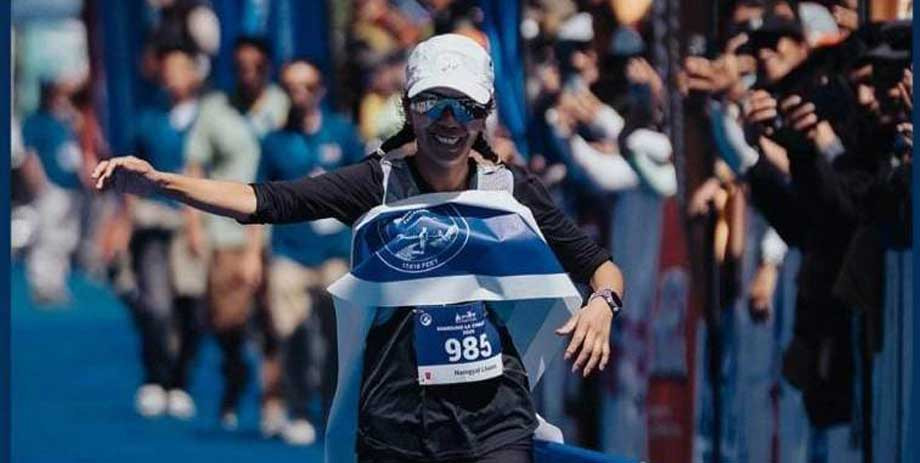In Conversation with Namgyal Lhamo, Athlete

Q. Please introduce yourself and share how your interest in athletics began.
Jullay! My name is Namgyal Lhamo, and I am from Domkhar village. I studied up to Class 5 in my village school, continued till Class 8 at Government Middle School Housing Colony, and completed Classes 10 and 12 at Government Girls Higher Secondary School, Leh. I later earned my graduation degree from IGNOU.
I was always passionate about running and took part in various short-distance races during my school days, often winning titles. While pursuing higher secondary education, a friend, Jigmet Dolma, encouraged me to take my interest further and try long-distance running. That motivation led me to start participating in marathons across different states and countries.
I am grateful to the organizers of the Ladakh Marathon for bringing runners from around the world to our region and providing local athletes with greater opportunities and exposure. Thanks to this event, many of us, including myself, have had the chance to compete in marathons beyond Ladakh.
Q. Tell us about your journey and the accomplishments you have achieved.
My journey as a runner truly began with the Ladakh Marathon, which provided me with the exposure and platform to compete in different marathon categories. Through this opportunity, I learned about trail racing, and I am proud to be the only woman from Ladakh to enter that field.
In the Ladakh Marathon, I participated in the 42 km category almost every year. In 2022, I shifted my focus to ultra marathons. I have participated in the Khardongla Challenge (72 km) four times and have won every year.
I have also competed in trail races in four different states, guided and inspired by Tenzin Doma, a trail racer from Himachal Pradesh. I performed well in all four competitions.
Coming from a high-altitude region like Ladakh gives me a natural advantage in trail racing because we are accustomed to challenging terrain and thinner air, which builds strong stamina.
So far, I have won 22 medals in total: 8 gold, 9 bronze, and 5 silver.
Q. What is the biggest challenge you have faced as an athlete?
When I first participated in the Ladakh Marathon, I was recovering from fractured legs. Because of this, my family, friends, and even doctors discouraged me from running, fearing further injuries. The doctor advised me not to participate, warning that I might experience recurring ankle twists.
But deep in my heart, I felt strongly that I could do it. I refused to stay back and instead continued with regular medication and therapy while maintaining daily practice.
That was one major challenge. At present, the challenge I face is the lack of a proper coach or guide to help me improve and take my performance to the next level.
Q. What do you think is necessary to encourage more young athletes?
There is great scope and potential in this sport, especially for Ladakhi youth. Our natural body build and stamina are strong because we grow up in a harsh climate and high altitude, which is an advantage when competing in marathons.
However, only a few young boys and girls are currently interested in pursuing it further. To encourage more participation, there is a constant need for good coaches who can guide young athletes, help them improve their skills, and perform at a higher level.
Q. Do you think athletes from Ladakh are getting benefits and recognition, such as jobs under the sports quota?
I have been serving as an SPO in the Ladakh Police since 2019. Over the years, I have noticed very little appreciation for athletes. Many people have advised me to focus on further studies instead of “wasting time” running and participating in marathons, saying there is no future in it and that our achievements hold little value.
Currently, there is no dedicated sports quota for athletes here, even though we have been requesting and demanding it for a long time. Many of my senior fellow athletes, especially women, face the same struggle. For men, it is somewhat easier because they can often find opportunities in the Indian Army, but for women athletes it is much more challenging.
This lack of recognition and support, along with constant discouragement about the supposed “lack of scope,” is one of the main reasons many young people hesitate to pursue this field.
Q. What are your plans for the future?
I will be participating in the 100K IAU Asia-Oceania Championship in November 2025, representing India in Bangkok, Thailand. Along with me, five other runners will be representing the country. I am also aiming to participate in the Trail Running Championship to further challenge myself and gain more experience in international competitions.
Q. What is your advice to young boys and girls who want to become athletes?
Ladakhis are naturally gifted with stamina and endurance, and with hard work, we can achieve great success. We have many advantages, and if we focus on our passion and stay committed, Ladakhis can even represent the nation at the Olympics. The key is consistency, seriousness, and dedication.
I am always happy to guide anyone who wants to participate in ultra marathons or trail running. I am available to share my experiences, insights, and tips to help aspiring athletes achieve their goals.
Q. How important is it to balance sports and academics?
Balancing sports and academics is very important because it opens up more opportunities. Focusing on only one and neglecting the other is not always a good option. It is essential to pursue both, as this balance helps in avoiding future challenges and ensures overall growth.
Message to the readers
“There is great scope and potential for Ladakhis to become recognized athletes. I sincerely appeal to all parents to encourage their children to participate in sports alongside academics, as this will help them build a brighter and more successful future.”





